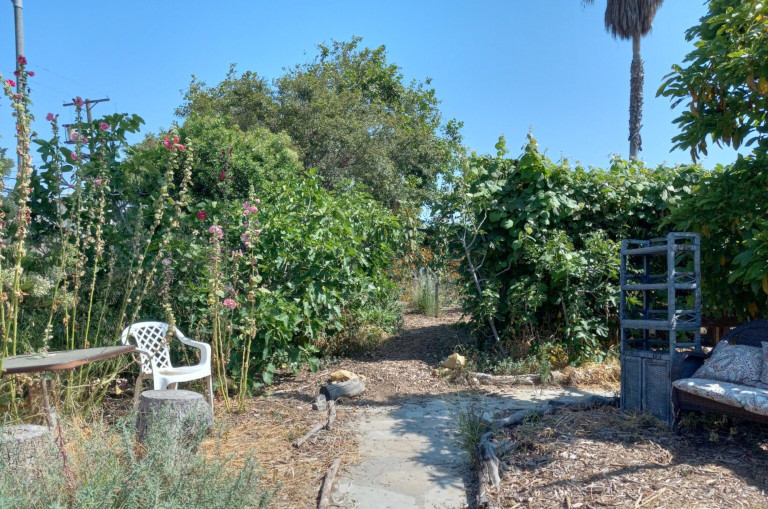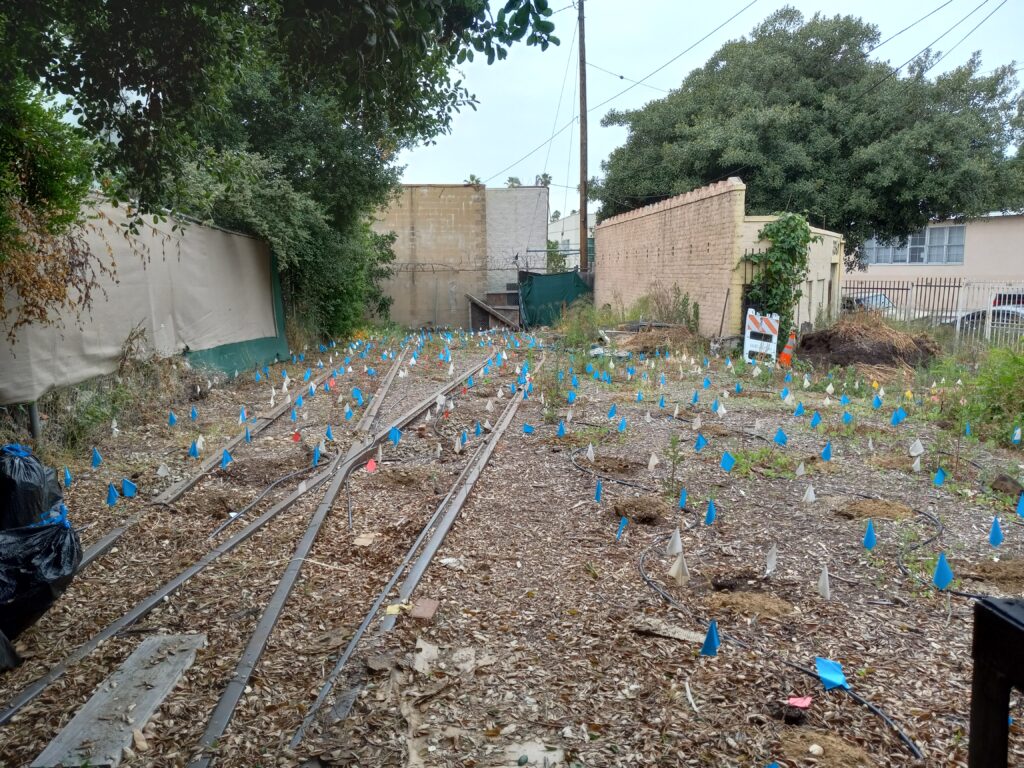In 2007, while studying sustainable communities for a chapter on the subject for State of the World 2008, I had the chance to visit several ecovillages. But none stood out like the Los Angeles Eco-Village. Surrounded by car-centric city sprawl, it was a tiny little oasis of green—literally and figuratively, with it being populated by many environmental activists. It was inspiring to meet them and learn about their efforts, and I daydreamed about what would happen if there was a little urban ecovillage in every city incubating citywide change, catalyzing human-centric infrastructure changes, teaching permaculture techniques, and so on. Even the simple act of composting became revolutionary: the courtyard in the center of the community was growing fruit trees, gardens, and one resident specifically noted how each year ‘we’re raising the soil level with the compost we make—which may get us through the collapse.’1
The verdant LAEV courtyard. (Images by Erik Assadourian)
By good fortune, I had the chance to visit again this summer. The community was still an oasis and still surrounded by sprawl, but the sprawl had evolved. Poverty was still present—including a homeless encampment right outside the ecovillage’s main building. But some of the mechanic shops (I had counted five in 2007) and car-dealerships had disappeared to be replaced by luxury apartment buildings, higher end restaurants, and of course, three Starbucks within a three-block walk.
The founder of the community, Lois Arkin, who showed me all around last time, was still there stirring up trouble and pushing for bigger things to come.2 Since my last visit, much had changed, but two things particularly stood out. First, an auto repair shop that abutted the community’s main building had been bought by the LAEV Institute and had been turned into a bike repair shop, community meeting space, and aquaponics project. The grounds, which had been contaminated from years of car repair, were covered in little flags—from an effort to remediate the grounds with plants and fungi (and study the results).
That’s a lot of phytoremediating going on!
Second, and even more impressive, was the “Learning Garden” across the street from LAEV’s main apartment building. This garden wasn’t there in 2007, but came from a prolonged struggle with the Los Angeles Unified School District to stop that quarter acre from being made into a school parking lot. Lois, along with scores of neighbors from the adjacent three block area, succeeded in stopping this paving of paradise. Now, adjacent to the school parking lot that did get built, there is a gorgeous garden—used to teach nearby school children in3—with a dozen varieties of fruit trees, an ancient sycamore, chickens, garden plots, and more. I even did a forest bathing session for a few folk while there and found deep refuge in the calm that evaporated as soon as I walked around the corner (where Vermont Avenue feels like walking along a congested highway).
And of course, I heard of many more plans for the future from Lois, including making a portion of the two streets LAEV is on into a car-free plaza (an effort that has been ongoing for years and now sounds close to succeeding), along with transforming an adjacent 800-foot long parking lane and sidewalk into an urban farm, and turning the remediated contaminated grounds of the former auto shop into an eco-hostel (which considering its closeness to many bus and metro lines could work well). All of this is made more remarkable by the fact that the LA Ecovillage is now in its 30th year on the ground (and Lois’ work far longer). When I visited in 2007, Lois was 70, now, she’s 86, and is still making plans, organizing, and taking action.
Lois and others from LAEV before heading to LA’s monthly CicLAvia, where a long stretch of road is made into a bike-only fairway and festival.
Only a Mirage?
But the community also seemed somewhat fragile—there was tension, perhaps between the founder, Lois, who has huge ambitions for what the community can be, and some members of the community who may have different views. Or who may have just come to LAEV because it offered a beautiful apartment in a friendly community at half the average rental price in LA (and where neighbors didn’t think you strange if you recycled or composted or rode a bike instead of driving a car). Or may like the community’s social change efforts but perhaps do not understand the ecological context (there is no ecoliteracy test to enter the community). Or may not see this as the final destination in their life journey, but just a temporary stop so aren’t trying to develop something enduring. If there are 40 residents, then surely there are at least 80 reasons.
One additional reason, perhaps, is what Nora Bateson said in this discussion on Deep(er) Ecology (with Bill Rees, Rex Weyler, and Nate Hagens): What makes intentional community both “not fun and a disaster” is that “they have a mission statement.” And each person interprets it differently, and changes their interpretation regularly, and this becomes “the thing you fight about most” instead of being in agreement on. In other words, living in community is generally hard—made harder when the purpose that might bring you together is converted from shared passion to hard work.4
That said, I’d also argue that shared responsibility and necessity that made community work in the past is also missing (as Charles Eisenstein makes a strong case for in Sacred Economics). Any time we treat our neighbors as just those annoying folk who play loud music (or complain when we do) and don’t depend on each other in myriad and interweaving ways, people can feel more annoying than necessary. As Lois noted to me, there are significant efforts to cultivate community interdependence—from work committees and regular potlucks, to shopping for the sick and even home hospice care for the dying. But in the individualized cultural context of the U.S., I imagine LAEV efforts can only do so much to combat the atomized way we live in the world.5
LAEV’s community kitchen and laundry in the courtyard.
Applying These Lessons to the Gaian Way
This applies as much to distributed ecospiritual communities as to physical communities. A wise individual, when I asked him about his experience helping to sustain an intentional ecospiritual community, noted that people like to shop for religion, and if it isn’t exactly what they’re looking for, they move on. Extreme individualism combined with the seemingly infinite choice available makes few willing to commit to a community and to the hard (and frequent and often thankless) work necessary to shape that community into something better.
That’s certainly something I’ve seen with the Gaian community too. Many individuals stop by briefly and before even getting to know the community have disappeared again. Many also reside here but perhaps don’t engage much beyond occasionally, as with many churchgoers (not surprising considering the many pressures and responsibilities people have already). It is a small core who have taken that next step—valuing the philosophy, internalizing it (and making it their own), working to make the community better, and sharing it—with friends, family, neighbors—to grow this community, and to help others understand that they too are dependent on and part of Gaia (and better act that way if they want to survive!). Ultimately, none of it is easy—in any community-building context—but perhaps finding ways to cultivate and nourish those future community members and leaders is the role that is most important to play for those who love their communities and want them to grow and flourish.
LAEV’s learning garden, complete with nooks to read or enjoy nature in!
The ancient sycamore holding court in the learning garden.
Endnotes
1) The collapse seemed nearly upon us back in 2007 when I presented global environmental data from Worldwatch’s Vital Signs at LAEV. But that intense concern, that fear, feels almost quaint now, 16 years later when collapse feels far more present. But imagine the soil depths LAEV now has to work with!
2) I say stirring up trouble for soon after I arrived, she gave me a tour and showed no fear going up to a guy parked nearby (and not from the community) and asking him, in a friendly way, to stop idling his car because of its climate impact. He did, but I could have seen many scenarios in which he didn’t!
3) At least until COVID, which ended field trips. But here’s another example of how silly we acted during the pandemic. What better place for kids to be during COVID than outdoors? And considering the school was next door, the kids and teachers could have walked there (so couldn’t infect each other on the bus ride over).
4) Lois noted one challenge LAEV faces is to what extent “future membership criteria” stresses ecological knowledge and practices. But even if they figure out the right way to screen for this, there is increasing tension—even within the environmentalist sub-population—on what is the right path to sustainability. Many believe in electrification and green consumerism, for example. Others in degrowth. Others in revolutionary deindustrialization. Will only those believing in a certain path be accepted as part of the community?
5) That is not easily solvable, though perhaps the collapse, ironically, will help strengthen community solidarity, at least in those communities that make it through.











